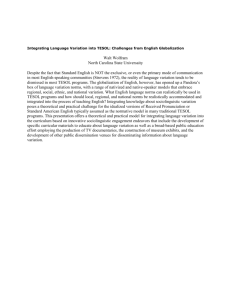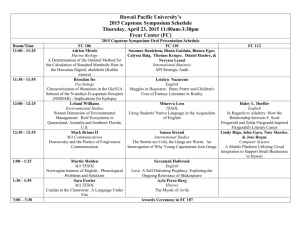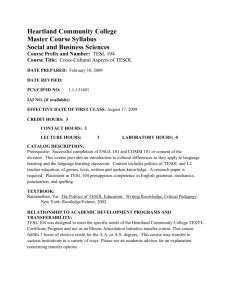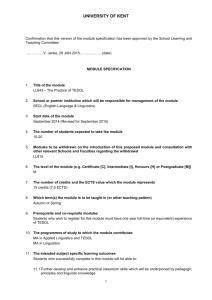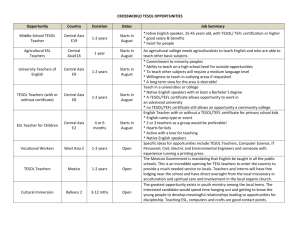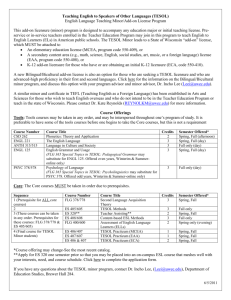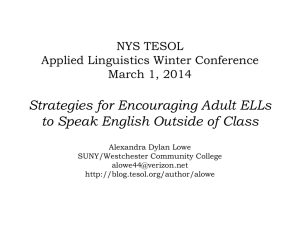NEW TESOL Course Proposals Summary
advertisement
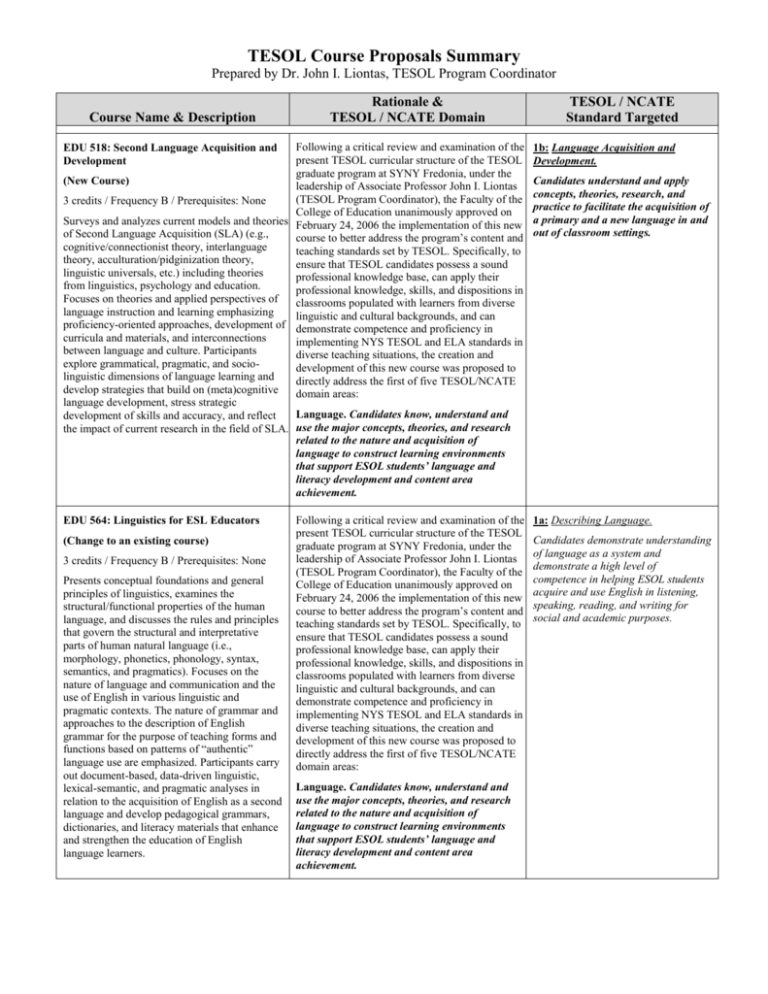
TESOL Course Proposals Summary Prepared by Dr. John I. Liontas, TESOL Program Coordinator Course Name & Description Rationale & TESOL / NCATE Domain Following a critical review and examination of the present TESOL curricular structure of the TESOL graduate program at SYNY Fredonia, under the (New Course) leadership of Associate Professor John I. Liontas (TESOL Program Coordinator), the Faculty of the 3 credits / Frequency B / Prerequisites: None College of Education unanimously approved on Surveys and analyzes current models and theories February 24, 2006 the implementation of this new of Second Language Acquisition (SLA) (e.g., course to better address the program’s content and cognitive/connectionist theory, interlanguage teaching standards set by TESOL. Specifically, to theory, acculturation/pidginization theory, ensure that TESOL candidates possess a sound linguistic universals, etc.) including theories professional knowledge base, can apply their from linguistics, psychology and education. professional knowledge, skills, and dispositions in Focuses on theories and applied perspectives of classrooms populated with learners from diverse language instruction and learning emphasizing linguistic and cultural backgrounds, and can proficiency-oriented approaches, development of demonstrate competence and proficiency in curricula and materials, and interconnections implementing NYS TESOL and ELA standards in between language and culture. Participants diverse teaching situations, the creation and explore grammatical, pragmatic, and sociodevelopment of this new course was proposed to linguistic dimensions of language learning and directly address the first of five TESOL/NCATE develop strategies that build on (meta)cognitive domain areas: language development, stress strategic Language. Candidates know, understand and development of skills and accuracy, and reflect the impact of current research in the field of SLA. use the major concepts, theories, and research related to the nature and acquisition of language to construct learning environments that support ESOL students’ language and literacy development and content area achievement. EDU 518: Second Language Acquisition and Development EDU 564: Linguistics for ESL Educators (Change to an existing course) 3 credits / Frequency B / Prerequisites: None Presents conceptual foundations and general principles of linguistics, examines the structural/functional properties of the human language, and discusses the rules and principles that govern the structural and interpretative parts of human natural language (i.e., morphology, phonetics, phonology, syntax, semantics, and pragmatics). Focuses on the nature of language and communication and the use of English in various linguistic and pragmatic contexts. The nature of grammar and approaches to the description of English grammar for the purpose of teaching forms and functions based on patterns of “authentic” language use are emphasized. Participants carry out document-based, data-driven linguistic, lexical-semantic, and pragmatic analyses in relation to the acquisition of English as a second language and develop pedagogical grammars, dictionaries, and literacy materials that enhance and strengthen the education of English language learners. Following a critical review and examination of the present TESOL curricular structure of the TESOL graduate program at SYNY Fredonia, under the leadership of Associate Professor John I. Liontas (TESOL Program Coordinator), the Faculty of the College of Education unanimously approved on February 24, 2006 the implementation of this new course to better address the program’s content and teaching standards set by TESOL. Specifically, to ensure that TESOL candidates possess a sound professional knowledge base, can apply their professional knowledge, skills, and dispositions in classrooms populated with learners from diverse linguistic and cultural backgrounds, and can demonstrate competence and proficiency in implementing NYS TESOL and ELA standards in diverse teaching situations, the creation and development of this new course was proposed to directly address the first of five TESOL/NCATE domain areas: Language. Candidates know, understand and use the major concepts, theories, and research related to the nature and acquisition of language to construct learning environments that support ESOL students’ language and literacy development and content area achievement. TESOL / NCATE Standard Targeted 1b: Language Acquisition and Development. Candidates understand and apply concepts, theories, research, and practice to facilitate the acquisition of a primary and a new language in and out of classroom settings. 1a: Describing Language. Candidates demonstrate understanding of language as a system and demonstrate a high level of competence in helping ESOL students acquire and use English in listening, speaking, reading, and writing for social and academic purposes. EDU 565: Language and Learning: Psychoand Sociolinguistic Considerations for Educators of ELL Students (Change to an existing course) 3 credits / Frequency B / Prerequisites: EDU 564 Explores fundamental questions about the nature of language, memory, and cognition, approaches the evolving field of psycho- and sociolinguistics from a variety of perspectives, including different theoretical positions, various research strategies, and classical versus more contemporary research, and discusses sociolinguistic phenomena such as code switching, dialects and idiolects, language transfer, loan words, and appropriate discourse, including common misconceptions regarding “Spanglish” and other linguistic phenomena associated with “languages in contact.” Fundamental issues and principles of psychoand sociolinguistics are presented in a balanced way that is accessible to all course participants. Participants share with other classmates everyday examples of “language use,” apply theoretical models and crosslinguistic scientific findings relative to the cognition and socialization of language to classroom practice through research and projects, and compile a compendium of “best psycho- and sociolinguistic practices” to enable classroom teachers to stimulate active learning in first and second languages. EDU 569: Assessment and Evaluation of English Language Learners (ELLs) (New Course) 3 credits / Frequency B / Prerequisites: None Views current district assessments through psychometric and socio-cultural models of assessment focusing on how schools measure language and achievement for ELLs. Through a unified theory of construct validity, participants will identify the purpose, instrument, method, and use of assessments and evaluations most appropriate and valid for ELLs. This course explores relationships of assessment to instruction, consequences of assessments, test score interpretation, state and federal assessment policies, and those assessments unique for ELLs. Participants share with other classmates examples from the classroom of both formal and informal assessments of language and content for ELLs, and develop a conceptual understanding of basic psychometric concepts (grade level equivalent, percentile rank, cut-off scores, standard error of measurement) and how best to apply these concepts in schools with language minority students. Following a critical review and examination of the present TESOL curricular structure of the TESOL graduate program at SYNY Fredonia, under the leadership of Associate Professor John I. Liontas (TESOL Program Coordinator), the Faculty of the College of Education unanimously approved on February 24, 2006 the implementation of this new course to better address the program’s content and teaching standards set by TESOL. Specifically, to ensure that TESOL candidates possess a sound professional knowledge base, can apply their professional knowledge, skills, and dispositions in classrooms populated with learners from diverse linguistic and cultural backgrounds, and can demonstrate competence and proficiency in implementing NYS TESOL and ELA standards in diverse teaching situations, the creation and development of this new course was proposed to directly address the first two TESOL/NCATE domain areas: Language. Candidates know, understand and use the major concepts, theories, and research related to the nature and acquisition of language to construct learning environments that support ESOL students’ language and literacy development and content area achievement. Culture. Candidates know, understand and use the major concepts, principles, theories, and research related to the nature and role of culture and cultural groups to construct learning environments that support ESOL students’ cultural identities, language and literacy development, and content-area achievement. Following a critical review and examination of the present TESOL curricular structure of the TESOL graduate program at SYNY Fredonia, under the leadership of Associate Professor John I. Liontas (TESOL Program Coordinator), the Faculty of the College of Education unanimously approved on February 24, 2006 the implementation of this new course to better address the program’s content and teaching standards set by TESOL. Specifically, to ensure that TESOL candidates possess a sound professional knowledge base, can apply their professional knowledge, skills, and dispositions in classrooms populated with learners from diverse linguistic and cultural backgrounds, and can demonstrate competence and proficiency in implementing NYS TESOL and ELA standards in diverse teaching situations, the creation and development of this new course was proposed to directly address the fourth TESOL/NCATE domain area: Assessment. Candidates understand issues of assessment and use standards-based assessment measures with ESOL students. 1a: Describing Language. Candidates demonstrate understanding of language as a system and demonstrate a high level of competence in helping ESOL students acquire and use English in listening, speaking, reading, and writing for social and academic purposes. 1b. Language Acquisition and Development. Candidates understand and apply concepts, theories, research, and practice to facilitate the acquisition of a primary and a new language in and out of classroom settings. 2a. Nature and Role of Culture. Candidates know, understand and use the major concepts, principles, theories, and research related to the nature and role of culture in language development and academic achievement that support individual students’ learning. 2b. Cultural Groups and Identity. Candidates know, understand and use knowledge of how cultural groups and students’ cultural identities affect language learning and school achievement. 4a. Issues of Assessment for ESL. Candidates understand various issues of assessment (e.g. cultural and linguistic bias, political, social, and psycho-logical factors) in assessment, IQ, and special education testing (including gifted and talented); the importance of standards; and the difference between language proficiency and other types of assessment (e.g. standardized achievement tests of overall mastery), as they affect ESOL student learning. 4b. Language Proficiency Assessment. Candidates know and use a variety of standards-based language proficiency instruments to inform their instruction and understand their uses for identification, placement, and demonstration of language growth of ESOL students. 4c. Classroom-Based Assessment for ESL. Candidates know and use a variety of performance-based assessment tools and techniques to inform instruction.
